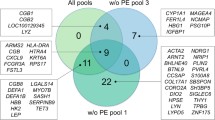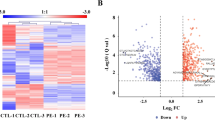Abstract.
Extensive endothelial dysfunction has been regarded as the central hallmark in the pathogenesis of pre-eclampsia, but the mechanisms leading to this dysfunction remain unclear. The levels of many metabolism substances, such as lipid peroxides, are changed in plasma of patients with pre-eclampsia. Some of those might be associated with the occurrence of pre-eclampsia. Our research was trying to reveal the source of metabolism substances which were elevated in plasma of preeclamptic patients. The expression of many metabolism-associated genes in 3 preeclamptic and strictly matched 3 normal placentas were compared by employing DNA chip representing 243 human hormone-associated genes. The results showed that, many redox metabolism-related genes (GenBank: U78168, X16699, D32143, AL035079, AF069668, X53463, J03746, X02317, X91247, etc) were found more highly expressed in preeclamptic placenta than that in normal placenta. Additionally, the mRNA levels of some genes which were related to other metabolism such as hormone (GenBank: NM_001718, Z22535, M38180, M76665, X75252, J03258, U56725), were also higher in placenta of patients with pre-eclampsia. Furthermore, many transcription factor genes were also up-regulated in pre-eclampsia. It suggested that, the change of genes expression in placenta was associated with the change of metabolism in patients with pre-eclampsia.
Similar content being viewed by others
References
Baelde HJ, Cleton-Jansen AM, van Beerendonk H, Namba M, Bovee JV, Hogendoorn PC (2001) High quality RNA isolation from tumours with low cellularity and high extracellular matrix component for cDNA microarrays: application to chondrosarcoma. J Clin Pathol 54:778–782
Barros JS, Baptista MG, Bairos VA (2002) Human chorionic gonadotropin in human placentas from normal and preeclamptic pregnancies. Arch Gynecol Obstet 266:67–71
Dekker GA, Sibai BM (1998) Etiology and pathogenesis of pre-eclampsia: current concepts. Am J Obstet Gynecol 179:1359–1375
Dietl J (2000) The pathogenesis of pre-eclampsia: new aspects. J Perinat Med 28:464–471
Elsheikh A, Creatsas G, Mastorakos G, Milingos S, Loutradis D, Michalas S (2001) The reninaldosterone system during normal and hypertensive pregnancy. Arch Gynecol Obstet 264:182–185
Faxen M, Nisell H, Kublickiene KR (2000) Altered gene expression of endothelin-A and endothelin-B receptors, but not endothelin-1, in myometrium and placenta from pregnancies complicated by pre-eclampsia. Arch Gynecol Obstet 264:143–149
Faxen M, Nisell H, Kublickiene KR (2001) Altered mRNA expression of ecNOS and iNOS in myometrium and placenta from women with pre-eclampsia. Arch Gynecol Obstet 265:45–50
Goldstein DP, Berkowitz RS (1994) Current management of complete and partial molar pregnancy. J Reprod Med 39:139–146
Halhali A, Tovar AR, Torres N, Bourges H, Garabedian M, Larrea F (2000) Pre-eclampsia is associated with low circulating levels of insulin-like growth factor I and 1,25-dihydroxyvitamin D in maternal and umbilical cord compartments. J Clin Endocrinol Metab 85:1828–1833
Hamer I, Wattiaux R, Wattiaux-De Coninck S (1995) Deleterious effects of xanthine oxidase on rat liver endothelial cells after ischemia/reperfusion. Biochim Biophys Acta 1269:145–152
Hefler LA, Tempfer CB, Bancher-Todesca D, Schatten C, Husslein P, Heinze G (2001) Placental expression and serum levels of cytokeratin-18 are increased in women with pre-eclampsia. J Soc Gynecol Investig 8:169–173
Hubel CA (1998) Dyslipidemia, iron, and oxidative stress in pre-eclampsia: assessment of maternal and feto-placental interactions. Semin Reprod Endocrinol 16:75–92
Hubel CA, Roberts JM (1999) Lipid metabolism and oxidative stress. In: Linhheimer MD, Roberts JM, Cunningham FG (ed) Chesley's hypertensive disorders in pregnancy, 2nd edn. Appleton and Large, Stanford, pp 453–475
Katusic ZS, Vanhoutte PM (1991) Superoxide anion and endothelial regulation of arterial tone. Semin Perinatol 15:30–33
Loverro G, Pansini V, Greco P, Vimercati A, Parisi AM, Selvaggi L (2001) Indications and outcome for intensive care unit admission during prerperium. Arch Gynecol Obstet 265:195–198
Norwitz ER, Repke JT (2000) Pre-eclampsia: prevention and management. J Soc Gynecol Investig 7:21–36
Ozkan SO, Korbeyli B, Bese T, Erel CT (2001) Acute cortical blindness complicating pre-eclampsia. Arch Gynecol Obstet 265:231–232
Pang ZJ, Zhou M, Chen Y, Wan J (1998) A protein-bound polysaccharide synergistically with lipopolysaccharide induces the nitric oxide release and antioxidant enzymes activities in mouse peritoneal macrophages. Am J Chin Med 26:133–141
Pang ZJ, Chen Y, Zhou M (2000) L929 cell conditioned medium protects RAW264.7 cell from oxidative injury through inducing antioxidant enzymes. Cytokine 12:944–950
Rdeman CW, Sacks GP, Sargent IL (1999) Pre-eclampsia: an excessive maternal inflammatory response to pregnancy. Am J Obstet Gynecol 180:499–506
Roberts JM (2000) Pre-eclampsia: what we know and what we do not know. Semin Perinatol 24:24–28
Sacks G, Sargent I, Redman C (1999) An innate view of human pregnancy. Immunol Today 20:114–118
Taylor RN, Roberts JM (1999) Endothelial cell dysfunction. In: Linhheimer MD, Roberts JM, Cunningham FG (ed) Chesley's hypertensive disorders in pregnancy, 2nd edn. Appleton and Large, Stanford, pp 395–429
Wacker J, Fruhauf J, Schulz M, Chiwora FM, Volz J, Becker K (2000) Riboflavin deficiency and pre-eclampsia. Obstet Gynecol 96:38–44
Walsh SW (1985) Pre-eclampsia: an imbalance in placental prostacyclin and thromboxane production. Am J Obstet Gynecol 152:335–340
Zeeman GG, Dekker GA (1992) Pathogenesis of pre-eclampsia: a hypothesis. Clin Obstet Gynecol 35:317–337
Ziadeh S, Yahaya A (2001) Pregnancy outcome at age 40 and older. Arch Gynecol Obstet 265:30–33
Acknowledgement.
This work was supported by the Special Funds for Major State Basic Research Project (Grant No. G1999055903).
Author information
Authors and Affiliations
Corresponding author
Rights and permissions
About this article
Cite this article
Pang, ZJ., Xing, FQ. Comparative profiling of metabolism-related gene expression in pre-eclamptic and normal pregnancies. Arch Gynecol Obstet 269, 91–95 (2004). https://doi.org/10.1007/s00404-002-0413-5
Received:
Accepted:
Published:
Issue Date:
DOI: https://doi.org/10.1007/s00404-002-0413-5




